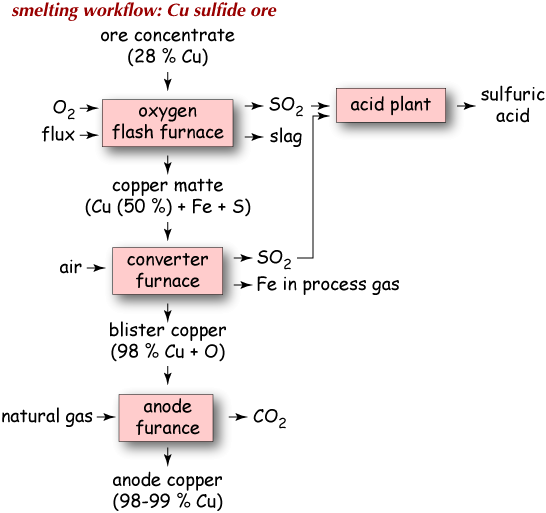- Copper: smelting and classification
- Copper that is mined from copper ore, after beneficiation, becomes high quality copper concentrate. Then, after being smelted, refined copper and copper products are yielded.
- There are two ways of smelting copper, one is pyrometallurgy, the other hydrometallurgical. Nowadays, the main smelting method is pyrometallurgy, which accounts for 85% of output in the world.
- The details are as follows:
- A. Pyrometallurgy
- Pyrometallurgy usually adopts original ore, in which its content can reach 20%-30% after mineral processing. Copper concentrate is put into an airtight blast furnace, reverberatory, electric furnace, or flash furnace for matte smelting. The output of molten matte is then put into the converter for converting into a blister copper, and next into another kind of reverberatory. Following oxidation refining complex or casting anodes for the purpose of electrolysis, electrolytic copper with grade of up to 99.9% is finally produced. The process is short and with strong adaptability, and copper recovery rates can reach 95%. However, because sulfur escapes as waste gas, and is not easy to recycle, pollution can easily result. In recent years, more and more pyrometallurgy methods have been developed,such as the silver method, Noranda process, Japan's mitsubishi process etc.

- Source: Metals: Scarce: Base - Copper Production: Ore Processing: Sulfide Ore- Smelting-- Web Gallery
- B. Hydrometallurgy
- Hydrometallurgy is usually suitable for low grade copper oxide, and the product of refined copper is called electrolytic copper. Modern hydrometallurgy methods usually can be separated as: the sulfating roasting- leaching- electrodeposition method; leaching- extraction- electrodeposition method; and bacterial leaching method. These methods are suitable for leaching of low grade complex ore, copper oxide ore, dump leaching contained waste copper ore, selection of tank leaching or in situ leaching. This smelting technology is gradually advancing, and is predicted to reach 20% of total output at the end of this century. Adopting hydrometallurgy will greatly reduce smelting costs.

- Source: http://www.jmeech.mining.ubc.ca/MINE290/proces/Fig_cu4.php
- Characteristics and comparisons of the two methods
- (1) Equipment for the latter method is simpler, but the impurity content is greater.
- (2) The latter method is subject to limitations in the grade of ore and types.
- (3) The cost of the former process is higher than the latter.
- According to the above, the hydrometallurgical method is relatively advantageous, but the scope of its applications is more limited, so not all the smelting of copper ore can adopt this technique. As technology has improved over recent years, more and more countries have applied the technique in copper ore smelting, including the US, Chile, Canada, Australia, Mexico and Peru.
- 1. Morphological classification in nature
 Native copper: copper content is over 99% (limited reserves).
Native copper: copper content is over 99% (limited reserves). Copper oxide ore: limited reserves
Copper oxide ore: limited reserves Copper sulfide ore: copper content is minimal (about 2%-3%). 80% of copper in the world is refined from copper sulfide
Copper sulfide ore: copper content is minimal (about 2%-3%). 80% of copper in the world is refined from copper sulfide- 2. Classified according to production process
- Copper concentrate: ore with high copper content before the smelting.
- Crude copper: the product resulting from copper concentrate being smelted, with a copper content of 95%-98%.
- Pure copper: has a copper content of over 99%, after firing or electrolysis. It is often called red copper and possesses good electrical conductivity, thermal conductivity and corrosion resistance.
- 3. Classified according to alloy composition
- Brass: pinchbeck alloy is one of the copper alloys.
- Bronze: copper-tin alloy, etc. Except when zinc and nickel are added, all other alloys that are formed by adding other elements can be called bronze, usually tin bronze, aluminum bronze, susceptibility of bronze etc.
- Cupronickel: cunico.
- Red copper: small amounts of deoxidizing elements or other elements can be added to form red copper.
- 4. Classified according to products' shape
- Copper tube, copper rod, copper wire, copper sheet, copper strip, copper bar, copper foil, etc.
-
About us
Contact us
Make a suggestion
- Metalpedia is a non-profit website, aiming to broaden metal knowledge and provide extensive reference database to users. It provides users reliable information and knowledge to the greatest extent. If there is any copyright violation, please notify us through our contact details to delete such infringement content promptly.


 Native copper: copper content is over 99% (limited reserves).
Native copper: copper content is over 99% (limited reserves). Copper oxide ore: limited reserves
Copper oxide ore: limited reserves Copper sulfide ore: copper content is minimal (about 2%-3%). 80% of copper in the world is refined from copper sulfide
Copper sulfide ore: copper content is minimal (about 2%-3%). 80% of copper in the world is refined from copper sulfide